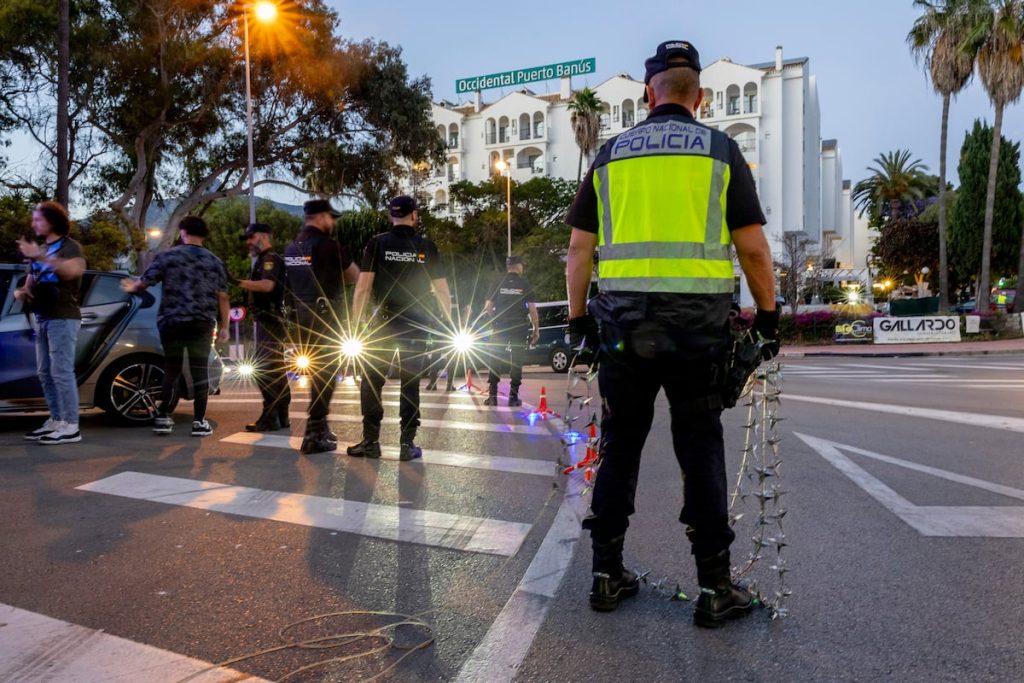A man in his thirties, with tattooed legs, a gold chain around his neck, and a luxury watch on his wrist, stops his gray Volkswagen Golf with a German license plate. He gets out slowly, leaving his keys, documentation, and a hundred euro bill on the hood. The passenger mimics his actions under the watchful eye of five police officers. One of the officers inspects the interior of the vehicle and discovers six or seven thousand euros in cash, while another officer checks identities. Everything is in order, and they are allowed to continue. It is nine-thirty at night, and three groups of the National Police’s Prevention and Reaction Unit are conducting the first checkpoint of their shift near Puerto Banús in Marbella, while another three are further down. They are searching for drugs, weapons, and fugitives related to organized crime.
The first checkpoint is located at the roundabout in Playas del Duque, one of the entrances to Avenida José Banús in the Nueva Andalucía district of Marbella. The officers patrol the area, aware that it is a hotspot for criminal activity. Even though the seven thousand euros found this time are considered small compared to what they have discovered before, it is not uncommon to come across individuals carrying forty thousand euros in their pockets, along with drugs, knives, and firearms. Marbella has recently experienced an increase in incidents involving firearms, with five shootings in the same area within two months, all related to drug trafficking. The rise in violence led to the implementation of Plan Marbella by the Ministry of the Interior, bringing in additional police units from other Andalusian provinces.
The heightened police presence is intended to address the recent spate of violence and prevent further escalation. While Marbella has a history of organized crime and drug-related violence, the current situation is considered manageable compared to countries like Sweden, Denmark, or the Netherlands, where organized crime leads to hundreds of deaths annually. However, the increase in gun violence and the presence of pistols and submachine guns among drug traffickers have raised concerns. Despite the area being heavily surveilled, criminal organizations continue to operate in Marbella to flaunt their wealth, conduct illicit activities, and evade law enforcement.
The police officers conduct random roadside checks, stopping vehicles and inspecting passengers for weapons and drugs. The profiles of those stopped often match a specific demographic: foreigners in their thirties, wearing sportswear and displaying tattoos. The officers remain vigilant, knowing that these inspections can lead to the capture of fugitives or provide valuable information for future investigations. The police maintain a visible presence in known hotspots, generating a deterrent effect on criminal activities. They are supported by plainclothes officers deployed in the area to gather intelligence and monitor criminal networks.
The night progresses with additional checkpoints and inspections, each lasting about twenty to thirty minutes. The officers adapt their tactics to remain unpredictable, knowing that criminals may be alerted and warned of their presence. The checkpoints serve multiple purposes, from identifying wanted individuals to detecting illegal activities. The collaboration between different police units, including the Drug and Organized Crime Units, ensures a coordinated effort in tackling criminal organizations. The night concludes with paperwork at the police station, including numerous citations and identifications. Despite the challenges faced by law enforcement in combating organized crime, they remain committed to maintaining public safety and upholding the rule of law in Marbella.


